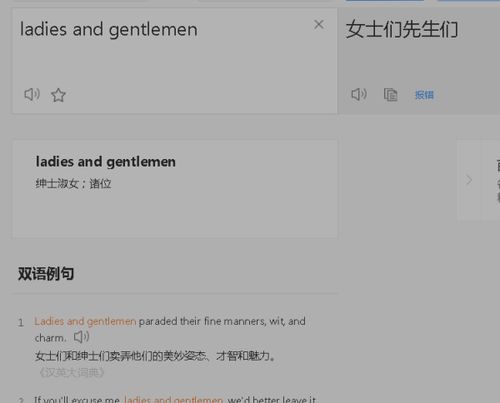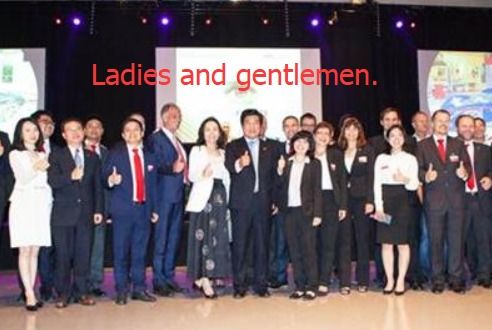What's the English for 'Ladies and Gentlemen'?
Ladies and Gentlemen: Unveiling the Elegance and Formality in English Address

In the realm of international communication, the choice of words and phrases holds immense significance. It transcends mere conveyance of meaning; it encompasses cultural sensitivity, social norms, and a respectful demeanor. Among the many English phrases that encapsulate such refined essence, "Ladies and Gentlemen" stands prominent. This timeless expression is a cornerstone of formal addresses, underpinned by centuries of tradition and etiquette. For those eager to explore the intricacies and applications of this phrase, this guide delves into its origin, usage, cultural significance, and its role in modern contexts.

The Elegance of "Ladies and Gentlemen"
At its core, "Ladies and Gentlemen" exudes a sense of formality and elegance. The term "Ladies" serves as a polite reference to women, reflecting an era where chivalry and courtesy were deeply ingrained in societal interactions. Meanwhile, "Gentlemen" pays homage to men, echoing a historical reverence for masculine honor and decorum. Together, they encapsulate a respectful tone suitable for various formal occasions, from diplomatic functions to theatrical performances.

The beauty of this phrase lies in its balance. It acknowledges both genders without favoring one over the other, thus promoting inclusivity within the bounds of formal address. In doing so, it speaks to the core values of equality and respect that are paramount in modern societies.

Origins and Evolution
The phrase "Ladies and Gentlemen" can be traced back to the late medieval and early modern periods in Europe. During this time, social hierarchies were rigidly defined, and courtly manners were of utmost importance. Addressing a gathering as "Ladies and Gentlemen" served as a marker of the speaker's own standing, signifying their rank and sophistication.
As society evolved, so did the use of this phrase. By the 18th and 19th centuries, it had become ubiquitous in theatres, concert halls, and other public venues, where a sense of occasion and gravitas was crucial. Performers and speakers would commence their engagements with this respectful salutation, setting the tone for an evening of elegance and refinement.
In the 20th and 21st centuries, the phrase has continued to adapt. While it retains its formal roots, it has also found its way into more casual contexts, such as weddings, graduations, and award ceremonies. Here, it serves as a unifying force, bringing together diverse groups under a shared sense of respect and importance.
Cultural Significance
Beyond its functional use, "Ladies and Gentlemen" carries significant cultural weight. In many Western cultures, it symbolizes tradition, pageantry, and a deep-seated respect for authority and仪式感. Its deployment at formal events such as state dinners, royal engagements, and awards nights underscores the gravitas of the occasion, invoking a sense of awe and reverence.
However, the phrase is not limited to Western cultures. Its adaptability has allowed it to cross borders, becoming a part of global etiquette. In Asia, Africa, and Latin America, for instance, "Ladies and Gentlemen" is often adopted as a standard form of address in formal settings, reflecting a shared commitment to respectful and polite interactions.
Modern Applications
In today's interconnected world, "Ladies and Gentlemen" continues to serve a variety of purposes. Here are some of the most common contexts in which this phrase is used:
1. Ceremonial Occasions: Whether it's a graduation ceremony, a wedding reception, or a corporate gala, addressing the audience as "Ladies and Gentlemen" immediately establishes a formal and celebratory atmosphere. It's a way of acknowledging the importance of the event and the participants' presence.
2. Public Announcements: In public transport, airports, and other busy venues, announcements prefixed with "Ladies and Gentlemen" catch people's attention effectively. This respectful tone ensures that important information is conveyed in a manner that respects the audience's time and dignity.
3. Entertainment: Performers in theatres, concert halls, and other live entertainment venues frequently begin their acts with "Ladies and Gentlemen," signaling the start of a memorable experience. This phrase serves as a bridge between the everyday world and the realm of imagination and performance.
4. Diplomatic Settings: At international conferences, summits, and diplomatic receptions, "Ladies and Gentlemen" is often used to introduce speakers, underscoring their authority and the significance of their words. It promotes a sense of unity and respect among diverse nations and cultures.
5. Educational Institutions: Graduation ceremonies are quintessential moments for students and their families. Addressing the graduates as "Ladies and Gentlemen" recognizes their achievements and paves the way for a memorable and solemn conclusion to their academic journey.
Beyond Formality: A Universal Gesture of Respect
Beyond its formal applications, "Ladies and Gentlemen" serves as a powerful symbol of respect and inclusivity. By addressing individuals in this manner, one acknowledges their inherent dignity and worth, regardless of their background, gender, or status. In an increasingly polarized world, such gestures of respect are crucial for fostering unity and mutual understanding.
Moreover, the phrase has a timeless appeal. Its use transcends specific historical periods or cultural contexts, making it a versatile tool for communicating respect and importance across generations and borders.
Learning to Use It Effectively
For those keen to adopt "Ladies and Gentlemen" into their formal interactions, there are a few key pointers to remember:
1. Pronunciation: Ensure that the phrase is pronounced clearly and confidently. A good pronunciation conveys authority and sincerity, setting the right tone for your engagement.
2. Context Awareness: Be mindful of the context in which you use the phrase. While it's perfectly suited for formal occasions, it may seem out of place in more casual settings.
3. Gender Sensitivity: The phrase is inherently inclusive, acknowledging both genders. However, in environments where gender specificity is required or preferred, alternative greetings such as "Ladies" or "Gentlemen" may be more appropriate.
4. Body Language: Pair the phrase with respectful body language, such as a bow or a curtsy (depending on cultural norms), to reinforce your sincerity and deference.
Conclusion
"Ladies and Gentlemen" is a phrase that transcends time and culture, embodying the essence of formal and respectful address. Its ability to foster unity, communicate authority, and invoke a sense of occasion makes it a valuable asset in the realm of international communication. Whether you're addressing a crowd at a grand ceremony or simply conveying important information in a public space, mastering this phrase can greatly enhance your ability to connect with others in a meaningful and respectful way. As we continue to navigate the complexities of global interaction, let us embrace the timeless elegance of "Ladies and Gentlemen," using it as a beacon of respect and inclusivity in all our endeavors.
- 上一篇: Picasa3:轻松开启无限循环的幻灯片播放之旅
- 下一篇: 一键清空:如何彻底删除所有零钱明细记录
-

-
 Ladies and Gentlemen资讯攻略11-15
Ladies and Gentlemen资讯攻略11-15 -

-

-
 探索话题的英文魅力资讯攻略04-09
探索话题的英文魅力资讯攻略04-09 -












